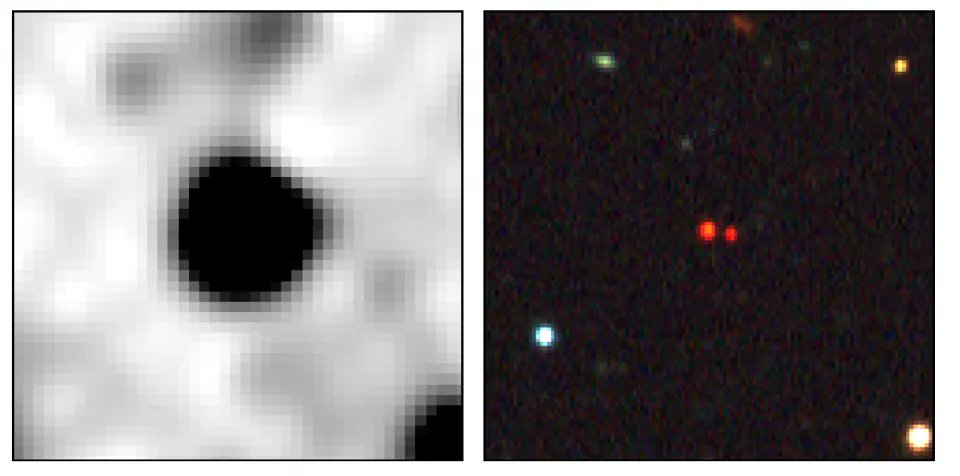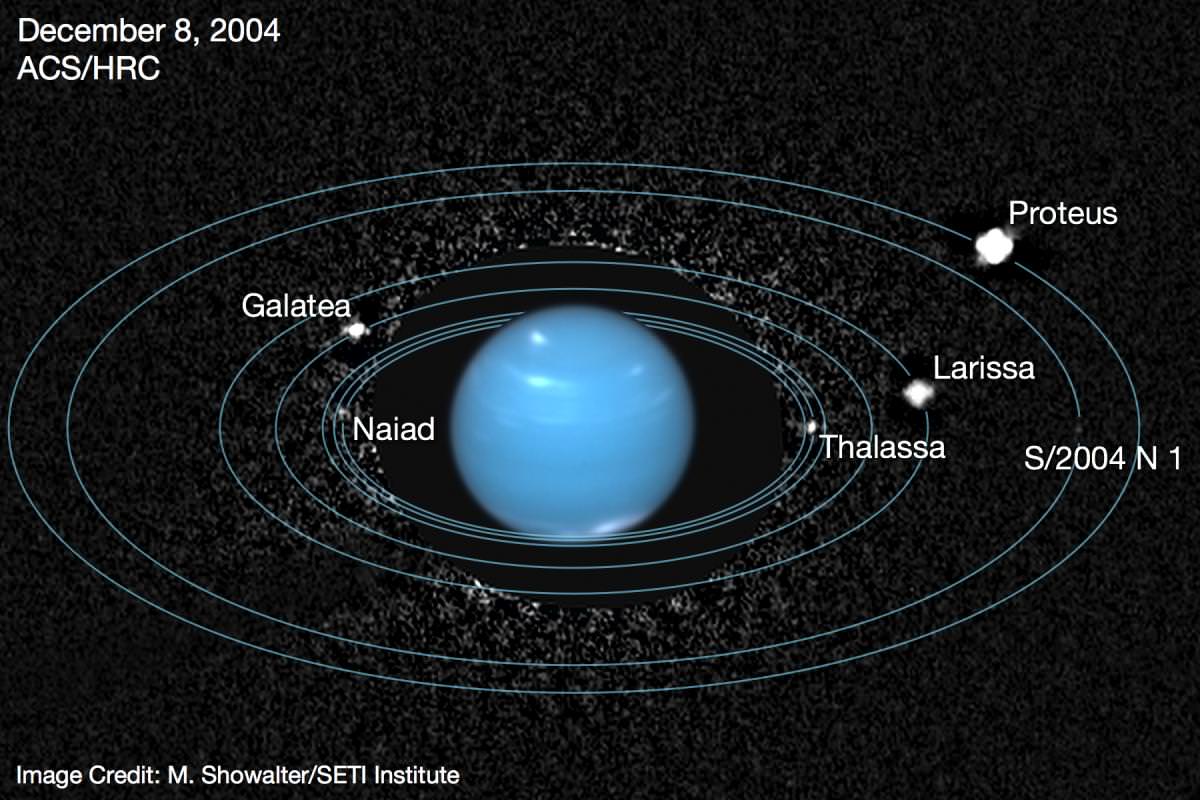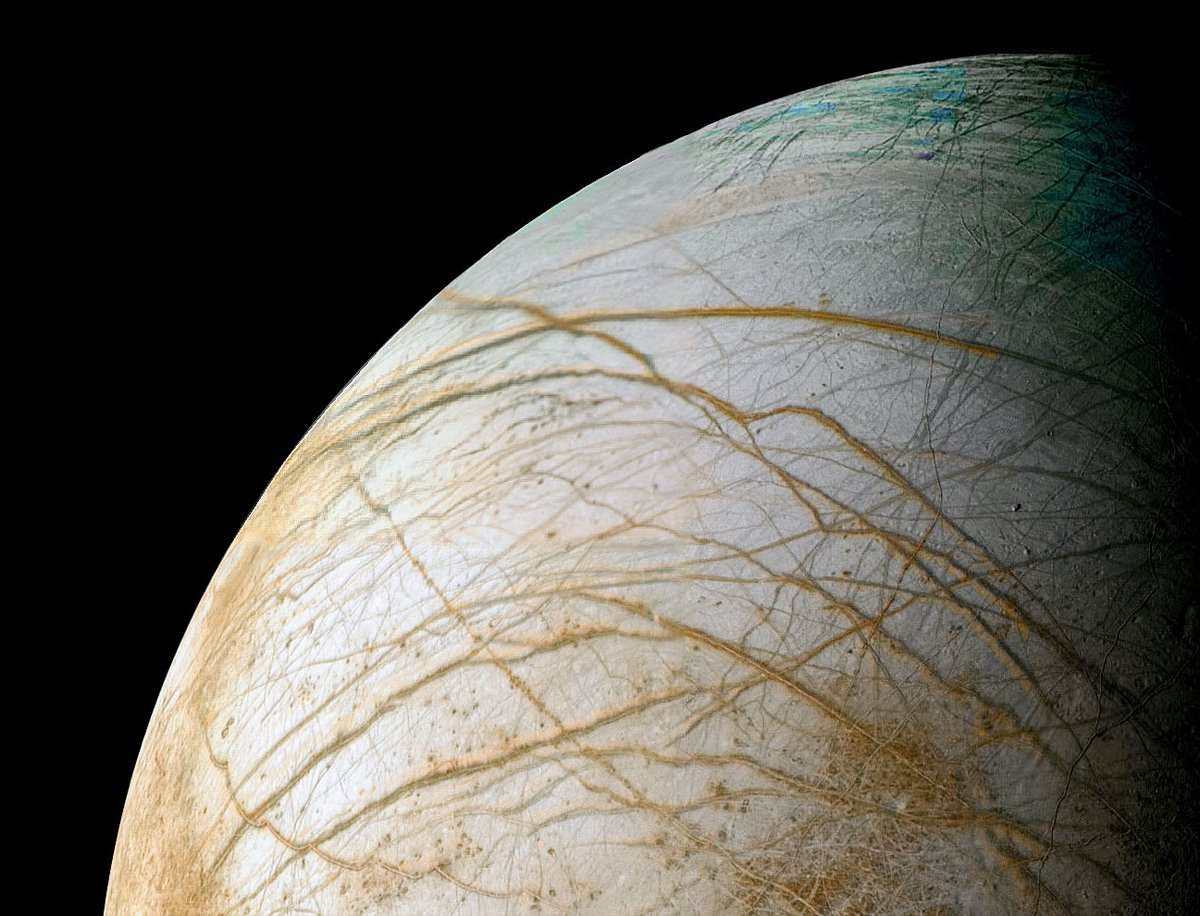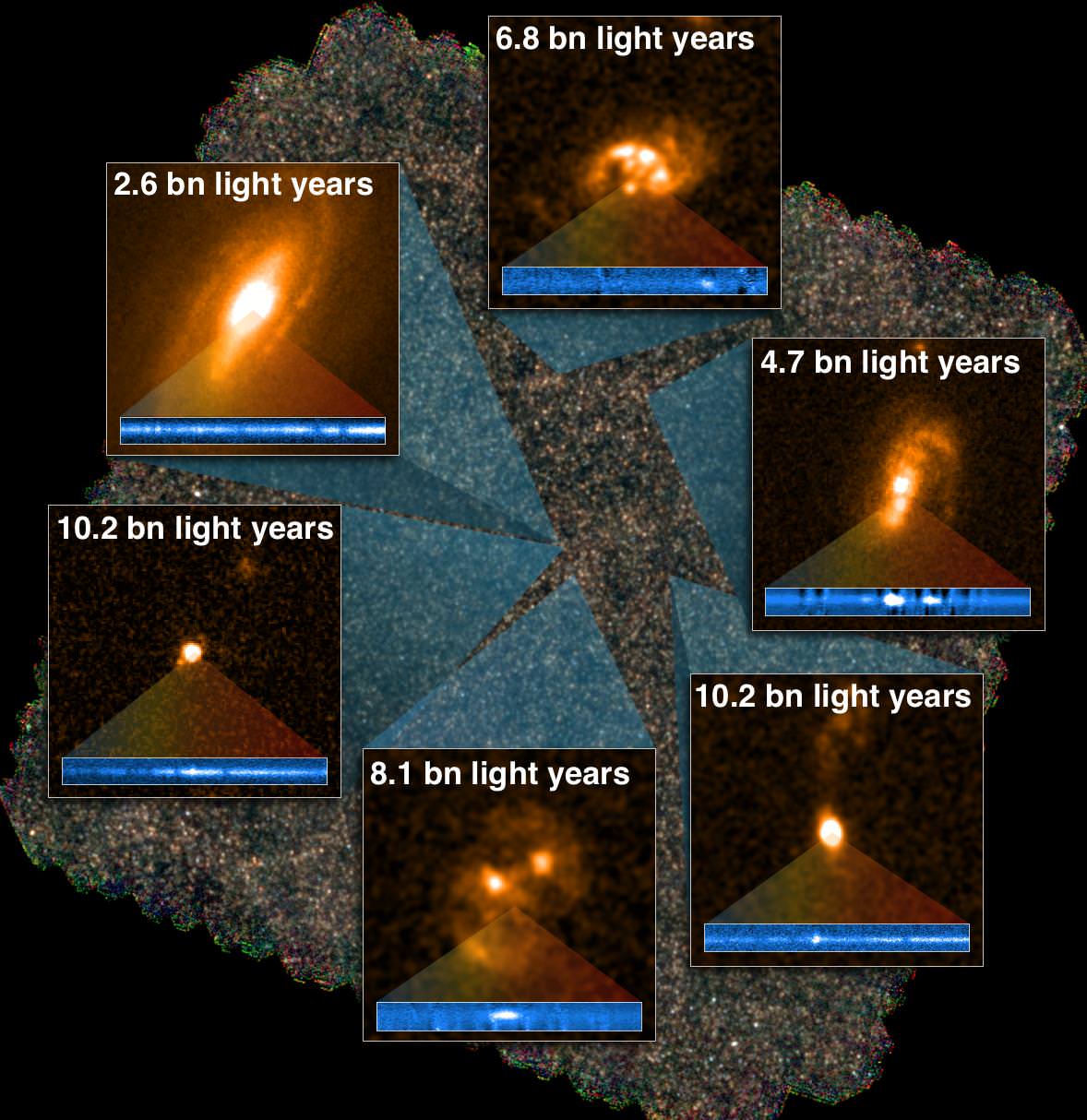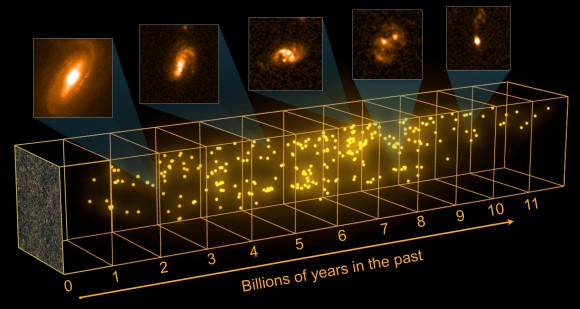We have discovered over 5,000 planets around other star systems. Amongst the veritable cosmic menagerie of exoplanets, it seems there is a real shortage of Neptune-sized planets close to their star. A new paper just published discusses a Saturn-sized planet close to its host star which should be experiencing mass loss, but isn’t. Studying this world offers a new insight into exoplanet formation across the Universe.
Continue reading “Saturn-Sized Exoplanet Isn’t Losing Mass Quickly Enough”Black Holes are Tearing Stars Apart All Around Us
Galaxy NGC3799 lies around 16 million light years from Earth. Any event observed today within that galaxy took place 16 million years ago. One such event was observed in February 2023 when a surge in brightness in the core was followed by a rapid dimming. The observations that followed revealed that the event was a star being torn apart by a supermassive black hole at the heart of the galaxy. This is not the first time such an event has been observed but it is the first to be within our galactic backyard suggesting it may be more common that first thought.
Continue reading “Black Holes are Tearing Stars Apart All Around Us”Twin Brown Dwarfs Discovered, Orbiting one Another at Three Times the Distance From the Sun to Pluto
Gravity is a funny force. The gravity of every given object technically impacts every other given object, though, in practice, large distance and small masses make those forces negligible for such interactions. But in some cases, especially when large groups are floating in empty space, gravity can still hold sway over considerable distances. Such is the case with a new pair of brown dwarfs found by astronomers at the Keck Observatory.
Continue reading “Twin Brown Dwarfs Discovered, Orbiting one Another at Three Times the Distance From the Sun to Pluto”Weekly Space Hangout – May 15, 2015: Finding, Studying and Visiting Other Worlds!
Host: Fraser Cain (@fcain)
Guests:
Jolene Creighton (@jolene723 / fromquarkstoquasars.com)
Brian Koberlein (@briankoberlein / briankoberlein.com)
Dave Dickinson (@astroguyz / www.astroguyz.com)
Morgan Rehnberg (cosmicchatter.org / @MorganRehnberg )
Alessondra Springmann (@sondy)
Continue reading “Weekly Space Hangout – May 15, 2015: Finding, Studying and Visiting Other Worlds!”
Did a Galactic Smashup Kick Out a Supermassive Black Hole?
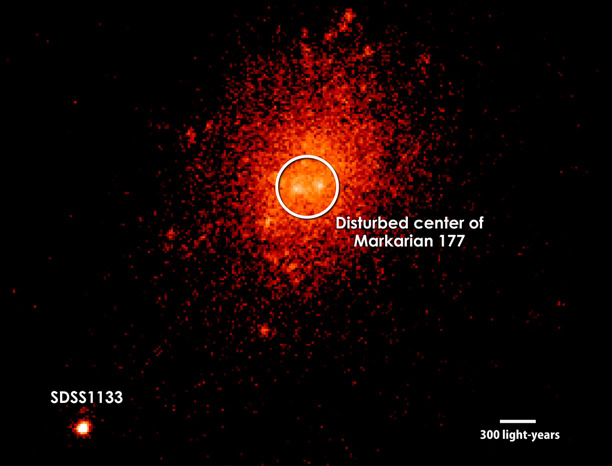
Crazy things can happen when galaxies collide, as they sometimes do. Although individual stars rarely impact each other, the gravitational interactions between galaxies can pull enormous amounts of gas and dust into long streamers, spark the formation of new stars, and even kick objects out into intergalactic space altogether. This is what very well may have happened to SDSS1133, a suspected supermassive black hole found thousands of light-years away from its original home.
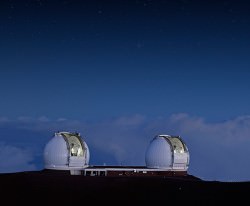
Seen above in a near-infrared image acquired with the Keck II telescope in Hawaii, SDSS1133 is the 40-light-year-wide bright source observed 2,300 light-years out from the dwarf galaxy Markarian 177, located 90 million light-years away in the constellation Ursa Major (or, to use the more familiar asterism, inside the bowl of the Big Dipper.)
The two bright spots at the disturbed core of Markarian 177 are thought to indicate recent star formation, which could have occurred in the wake of a previous collision.
“We suspect we’re seeing the aftermath of a merger of two small galaxies and their central black holes,” said Laura Blecha, an Einstein Fellow in the University of Maryland’s Department of Astronomy and a co-author of an international study of SDSS1133. “Astronomers searching for recoiling black holes have been unable to confirm a detection, so finding even one of these sources would be a major discovery.”
Interactions between supermassive black holes during a galactic collision would also result in gravitational waves, elusive phenomena predicted by Einstein that are high on astronomers’ most-wanted list of confirmed detections.
Read more: “Spotter’s Guide” to Detecting Black Hole Collisions
Watch an animation of how the suspected collision and subsequent eviction may have happened:
But besides how it got to where it is, the true nature of SDSS1133 is a mystery as well.
The persistently bright near-infrared source has been detected in observations going back at least 60 years. Whether or not SDSS1133 is indeed a supermassive black hole has yet to be determined, but if it isn’t then it’s a very unusual type of extremely massive star known as an LBV, or Luminous Blue Variable. If that is the case though, it’s peculiar even for an LBV; SDSS1133 would have had to have been continuously pouring out energy in a for over half a century until it exploded as a supernova in 2001.
To help determine exactly what SDSS1133 is, continued observations with Hubble’s Cosmic Origins Spectrograph instrument are planned for Oct. 2015.
“We found in the Pan-STARRS1 imaging that SDSS1133 has been getting significantly brighter at visible wavelengths over the last six months and that bolstered the black hole interpretation and our case to study SDSS1133 now with HST,” said Yanxia Li, a UH Manoa graduate student involved in the research.
And, based on data from NASA’s Swift mission the UV emission of SDSS1133 hasn’t changed in ten years, “not something typically seen in a young supernova remnant” according to Michael Koss, who led the study and is now an astronomer at ETH Zurich.
Regardless of what SDSS1133 turns out to be, the idea of such a massive and energetic object soaring through intergalactic space is intriguing, to say the least.
The study will be published in the Nov. 21 edition of Monthly Notices of the Royal Astronomical Society.
Source: Keck Observatory
New Technique Finds Water in Exoplanet Atmospheres
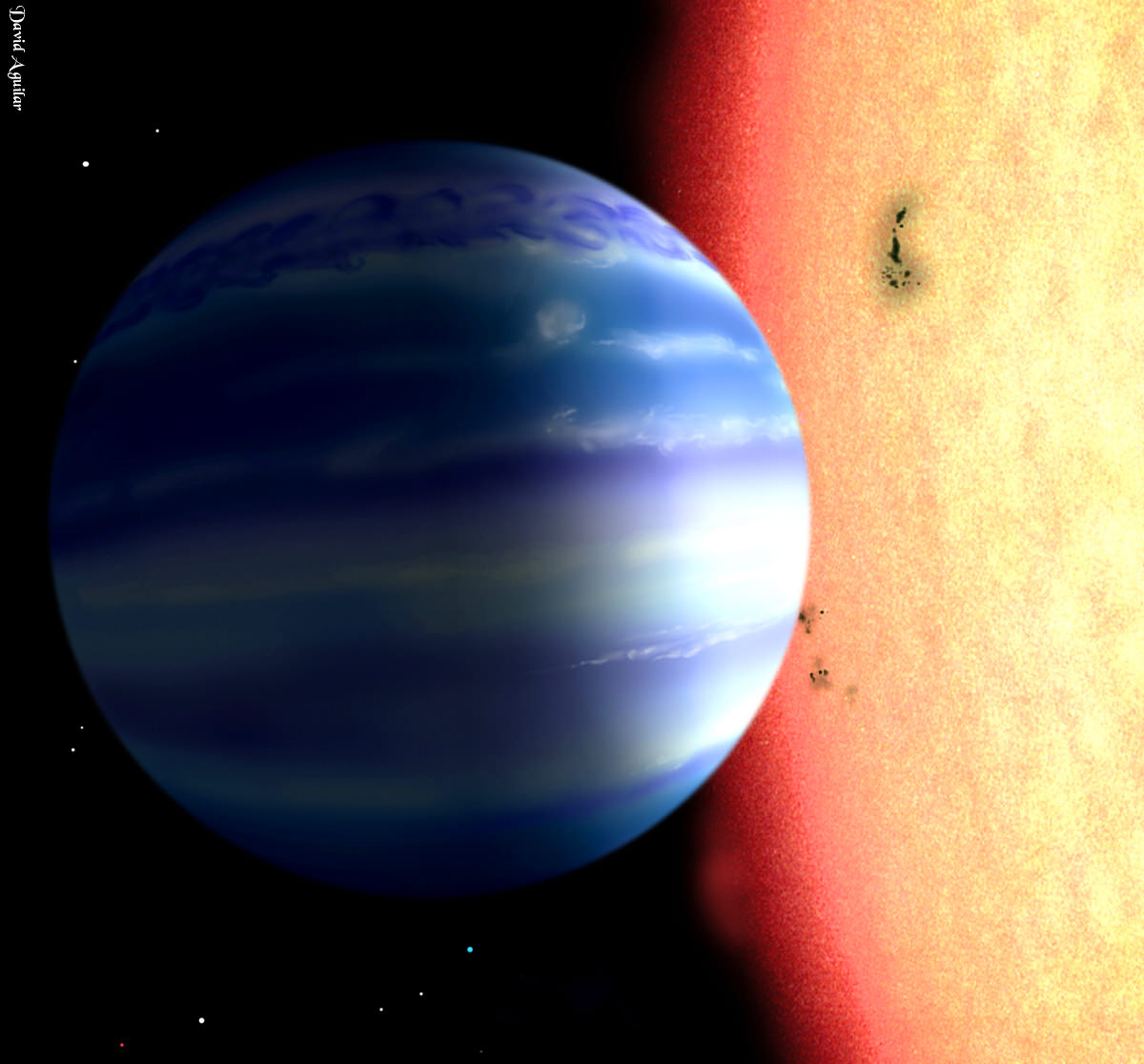
As more and more exoplanets are identified and confirmed by various observational methods, the still-elusive “holy grail” is the discovery of a truly Earthlike world… one of the hallmarks of which is the presence of liquid water. And while it’s true that water has been identified in the thick atmospheres of “hot Jupiter” exoplanets before, a new technique has now been used to spot its spectral signature in yet another giant world outside our solar system — potentially paving the way for even more such discoveries.
Researchers from Caltech, Penn State University, the Naval Research Laboratory, the University of Arizona, and the Harvard-Smithsonian Center for Astrophysics have teamed up in an NSF-funded project to develop a new way to identify the presence of water in exoplanet atmospheres.
Previous methods relied on specific instances such as when the exoplanets — at this point all “hot Jupiters,” gaseous planets that orbit closely to their host stars — were in the process of transiting their stars as viewed from Earth.
This, unfortunately, is not the case for many extrasolar planets… especially ones that were not (or will not be) discovered by the transiting method used by observatories like Kepler.
Watch: Kepler’s Universe: More Planets in Our Galaxy Than Stars
So the researchers turned to another method of detecting exoplanets: radial velocity, or RV. This technique uses visible light to watch the motion of a star for the ever-so-slight wobble created by the gravitational “tug” of an orbiting planet. Doppler shifts in the star’s light indicate motion one way or another, similar to how the Doppler effect raises and lowers the pitch of a car’s horn as it passes by.

But instead of using visible wavelengths, the team dove into the infrared spectrum and, using the Near Infrared Echelle Spectrograph (NIRSPEC) at the W. M. Keck Observatory in Hawaii, determined the orbit of the relatively nearby hot Jupiter tau Boötis b… and in the process used its spectroscopy to identify water molecules in its sky.
“The information we get from the spectrograph is like listening to an orchestra performance; you hear all of the music together, but if you listen carefully, you can pick out a trumpet or a violin or a cello, and you know that those instruments are present,” said Alexandra Lockwood, graduate student at Caltech and first author of the study. “With the telescope, you see all of the light together, but the spectrograph allows you to pick out different pieces; like this wavelength of light means that there is sodium, or this one means that there’s water.”
Previous observations of tau Boötis b with the VLT in Chile had identified carbon monoxide as well as cooler high-altitude temperatures in its atmosphere.
Now, with this proven IR RV technique, the atmospheres of exoplanets that don’t happen to cross in front of their stars from our point of view can also be scrutinized for the presence of water, as well as other interesting compounds.
“We now are applying our effective new infrared technique to several other non-transiting planets orbiting stars near the Sun,” said Chad Bender, a research associate in the Penn State Department of Astronomy and Astrophysics and a co-author of the paper. “These planets are much closer to us than the nearest transiting planets, but largely have been ignored by astronomers because directly measuring their atmospheres with previously existing techniques was difficult or impossible.”
Once the next generation of high-powered telescopes are up and running — like the James Webb Space Telescope, slated to launch in 2018 — even smaller and more distant exoplanets can be observed with the IR method… perhaps helping to make the groundbreaking discovery of a planet like ours.
“While the current state of the technique cannot detect earthlike planets around stars like the Sun, with Keck it should soon be possible to study the atmospheres of the so-called ‘super-Earth’ planets being discovered around nearby low-mass stars, many of which do not transit,” said Caltech professor of cosmochemistry and planetary sciences Geoffrey Blake. “Future telescopes such as the James Webb Space Telescope and the Thirty Meter Telescope (TMT) will enable us to examine much cooler planets that are more distant from their host stars and where liquid water is more likely to exist.”
The findings are described in a paper published in the February 24, 2014 online version of The Astrophysical Journal Letters.
Read more in this Caltech news article by Jessica Stoller-Conrad.
Sources: Caltech and EurekAlert press releases.
A Tale of a Lost Moon: Hubble Spies Neptune’s Moons and Its Rings
“That’s no moon…”
-B. Kenobi
But in this case, it is… a lost moon of Neptune not seen since its discovery in the late 1980’s.
A new announcement from the 45th Meeting of the Division for Planetary Sciences of the American Astronomical Society being held this week in Denver, Colorado revealed the recovery of a moon of Neptune that was only briefly glimpsed during the 1989 flyby of Voyager 2.
The re-discovery Naiad, the innermost moon of Neptune, was done by applying new processing techniques to archival Hubble images and was announced today by Mark Showalter of the SETI institute.
Collaborators on the project included Robert French, also from the SETI Institute, Dr. Imke de Pater of UC Berkeley, and Dr. Jack Lissauer of the NASA Ames Research Center.
The findings were a tour-de-force of new techniques applied to old imagery, and combined the ground-based 10 meter Keck telescope in Hawaii as well as Hubble imagery stretching back to December 2004.
The chief difficulty in recovering the diminutive moon was its relative faintness and proximity to the “dazzling” disk of Neptune. At roughly 100 kilometres in diameter and an apparent magnitude of +23.9, Naiad is over a million times fainter than +8th magnitude Neptune. It’s also the innermost of Neptune’s 14 known moons, and orbits once every 7 hours just 23,500 kilometres above the planet’s cloud tops. Neptune itself is about 49,000 kilometres in diameter, and only appears 2.3” in size from Earth. From our Earthly vantage point, Naiad only strays about arc second from the disk of Neptune, a tiny separation.
“Naiad has been an elusive target ever since Voyager left the Neptune system,” Showalter said in a recent SETI Institute press release. Voyager 2 has, to date, been the only mission to explore Uranus and Neptune.
To catch sight of the elusive inner moon, Showalter and team applied new analyzing techniques which filtered for glare and image artifacts that tend to “spill over” from behind the artificially occulted disk of Neptune.
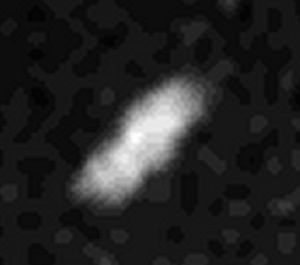
Other moons, such as Galatea and Thalassa — which were also discovered during the 1989 Voyager 2 flyby — are also seen in the new images. In fact, the technique was also used to uncover the as of yet unnamed moon of Neptune, S/2004 N1 which was revealed earlier this year.
Naiad is named after the band of nymphs in Greek mythology who inhabited freshwater streams and ponds. The Naiads differed from the saltwater-loving Nereids of mythology fame, after which another moon of Neptune discovered by Gerard Kuiper in 1949 was named.
It’s also intriguing to note that Naiad was discovered in a significantly different position in its orbit than expected. Clearly, its motion is complex due to its interactions with Neptune’s other moons.
“We don’t quite have enough observations to establish a refined orbit,” Mr. Showalter told Universe Today, noting that there may still be some tantalizing clues waiting to be uncovered from the data.
I know the burning question you have, and we had as well during the initial announcement today. Is it REALLY Naiad, or another unknown moon? Showalter notes that this possibility is unlikely, as both objects seen in the Hubble and Voyager data are the same brightness and moving in the same orbit. To invoke Occam’s razor, the simplest solution— that both sightings are one in the same object —is the most likely.
“Naiad is well inside Neptune’s Roche Limit, like many moons in the solar system,” Mr. Showalter also told Universe Today. Naiad is also well below synchronous orbit, and is likely subject to tidal deceleration and may one day become a shiny new ring about the planet.

And speaking of which, the tenuous rings of Neptune have also evolved noticeably since the 1989 Voyager flyby. First discovered from the ESO La Silla Observatory in 1984, data using the new techniques show that the knotted ring segments named the Adams and Le Verrier have been fading noticeably.
“In a decade or two, we may see an ‘arc-less’ ring,” Showalter noted during today’s Division for Planetary Sciences press conference. The two ring segments observed are named after Urbain Le Verrier and John Couch Adams, who both calculated the position of Neptune due to orbital perturbations of the position of Uranus. Le Verrier beat Adams to the punch, and Neptune was first sighted from the Berlin Observatory on the night of September 23rd, 1846. Observers of the day were lucky that both planets had undergone a close passage just decades prior, or Neptune may have gone unnoticed for considerably longer.
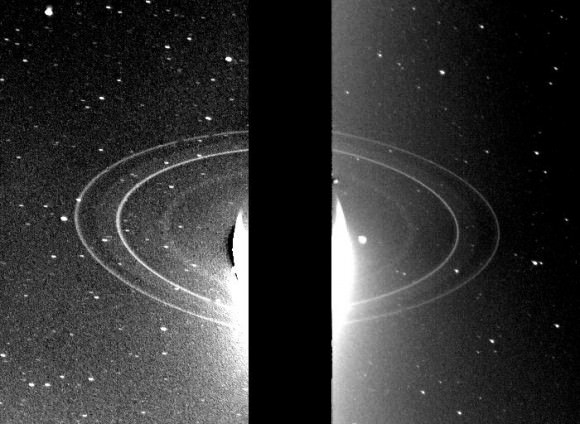
Neptune has completed just over one 164.8 year orbit since its discovery. It also just passed opposition this summer, and is currently a fine telescopic object in the constellation Aquarius.
Unfortunately, there aren’t any plans for a dedicated Neptune mission in the future. New Horizons will cross the orbit of Neptune in August 2014, though it’s headed in the direction of Pluto, which is currently in northern Sagittarius. New Horizons was launched in early 2006, which gives you some idea of just how long a “Neptune Orbiter” would take to reach the outermost ice giant, given today’s technology.
This represents the first time that Naiad has been imaged from the vicinity of Earth, and demonstrates a new processing technique capable of revealing new objects in old Hubble data.
“We keep discovering new ways to push the limit of what information can be gleaned from Hubble’s vast collection of planetary images,” Showalter said in the SETI press release.
Congrats to Showalter and team on the exciting recovery… what other moons, both old and new, lurk in the archives waiting to be uncovered?
– Read today’s SETI Institute press release on the recovery of Naiad.
-Be sure to follow all the action at the 45th DPS conference in Denver this week!
Keck Spots A Galaxy Fueled With Ancient Gas

“Primordial hydrogen” sounds like a great name for a band. It’s also a great thing to find when you’re looking at a galaxy. This ancient gas is a leftover of the Big Bang, and astronomers discovered it in a faraway star-forming galaxy that was created when the universe was young.
A continuous stream of gas was likely responsible for a cornucopia of star formation that took place about 10 billion years ago, when galaxies were churning out starbirths at a furious rate.
The astronomers spotted the gas by using a quasar that lit up the fuel from behind. Quasars a handy tool to use if you want to illuminate something, because even though quasars don’t live for very long in cosmic terms — they occur when matter falls into a ginormous black hole — they are extremely bright. Since the gas absorbs the light at certain frequencies, the absorption lines that show up in spectrometers reveal information about the composition, temperature and density of the gas.
“This is not the first time astronomers have found a galaxy with nearby gas, revealed by a quasar. But it is the first time that everything fits together,” stated Neil Crighton, who is with the Max Planck Institute for Astronomy and Swinburne University and led the research. His team found the galaxy using the Keck I telescope in Hawaii.
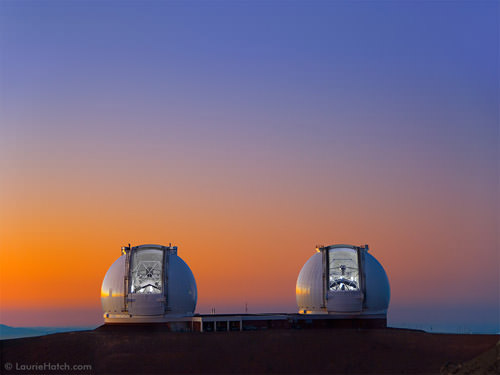
“The galaxy is vigorously forming stars,” added Crighton, “and the gas properties clearly show that this is pristine material, left over from the early universe shortly after the Big Bang.”
Q1442-MD50 (as the galaxy is called) is 11 billion light years away from us — pretty close to the start of the universe about 13.8 billion years ago. The quasar that lit it up is called QSO J1444535+291905.
“Since this discovery is the result of a systematic search, we can now deduce that such cold flows are quite common,” stated Joseph Hennawi, the leader of the ENIGMA research group at the Max Planck Institute for Astronomy. “We only had to search 12 quasar-galaxy pairs to discover this example. This rate is in rough agreement with the predictions of supercomputer simulations, which provides a vote of confidence for our current theories of how galaxies formed.”
You can read more details in the article (which is in Astrophysical Letters) or in this preprint version on Arxiv.
Source: Keck Observatory
Hydrogen Peroxide Could Feed Life on Europa
According to research by NASA astronomers using the next-generation optics of the 10-meter Keck II telescope, Jupiter’s ice-encrusted moon Europa has hydrogen peroxide across much of the surface of its leading hemisphere, a compound that could potentially provide energy for life if it has found its way into the moon’s subsurface ocean.
“Europa has the liquid water and elements, and we think that compounds like peroxide might be an important part of the energy requirement,” said JPL scientist Kevin Hand, the paper’s lead author. “The availability of oxidants like peroxide on Earth was a critical part of the rise of complex, multicellular life.”
The paper, co-authored by Mike Brown of the California Institute of Technology in Pasadena, analyzed data in the near-infrared range of light from Europa using the Keck II Telescope on Mauna Kea, Hawaii, over four nights in September 2011. The highest concentration of peroxide found was on the side of Europa that always leads in its orbit around Jupiter, with a peroxide abundance of 0.12 percent relative to water. (For perspective, this is roughly 20 times more diluted than the hydrogen peroxide mixture available at drug stores.) The concentration of peroxide in Europa’s ice then drops off to nearly zero on the hemisphere of Europa that faces backward in its orbit.
Hydrogen peroxide was first detected on Europa by NASA’s Galileo mission, which explored the Jupiter system from 1995 to 2003, but Galileo observations were of a limited region. The new Keck data show that peroxide is widespread across much of the surface of Europa, and the highest concentrations are reached in regions where Europa’s ice is nearly pure water with very little sulfur contamination.
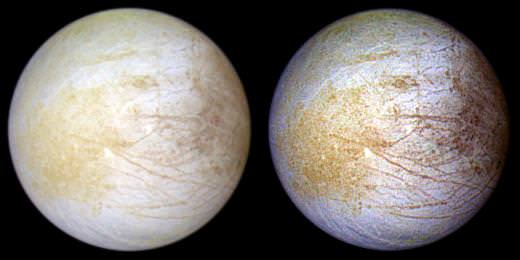
The peroxide is created by the intense radiation processing of Europa’s surface ice that comes from the moon’s location within Jupiter’s strong magnetic field.
“The Galileo measurements gave us tantalizing hints of what might be happening all over the surface of Europa, and we’ve now been able to quantify that with our Keck telescope observations,” Brown said. “What we still don’t know is how the surface and the ocean mix, which would provide a mechanism for any life to use the peroxide.”
Read more: Evidence for a Deep Ocean on Europa Might Be Found on its Surface
The scientists think hydrogen peroxide is an important factor for the habitability of the global liquid water ocean under Europa’s icy crust because hydrogen peroxide decays to oxygen when mixed into liquid water. “At Europa, abundant compounds like peroxide could help to satisfy the chemical energy requirement needed for life within the ocean, if the peroxide is mixed into the ocean,” said Hand.
(Source: NASA)
What’s notable to add, on March 26, 2013, the U.S. President signed a bill that would increase the budget for NASA’s planetary science program as well as provide $75 million for the exploration of Europa. Exactly how the funds will be used isn’t clear — perhaps for components on the proposed Europa Clipper mission? — but it’s a step in the right direction for learning more about this increasingly intriguing world. Read more on SETI’s Destination: Europa blog.
The Brightest Galaxies in the Universe Were Invisible… Until Now
Hubble images of six of the starburst galaxies first found by ESA’s Herschel Space Observatory (Keck data shown below each in blue)
Many of the brightest, most actively star-forming galaxies in the Universe were actually undetectable by Earth-based observatories, hidden from view by thick clouds of opaque dust and gas. Thanks to ESA’s Herschel space observatory, which views the Universe in infrared, an enormous amount of these “starburst” galaxies have recently been uncovered, allowing astronomers to measure their distances with the twin telescopes of Hawaii’s W.M. Keck Observatory. What they found is quite surprising: at least 767 previously unknown galaxies, many of them generating new stars at incredible rates.
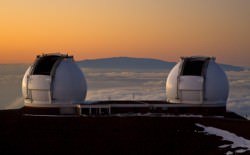 Although nearly invisible at optical wavelengths these newly-found galaxies shine brightly in far-infrared, making them visible to Herschel, which can peer through even the densest dust clouds. Once astronomers knew where the galaxies are located, they were able to target them with Hubble and, most importantly, the two 10-meter Keck telescopes — the two largest optical telescopes in the world.
Although nearly invisible at optical wavelengths these newly-found galaxies shine brightly in far-infrared, making them visible to Herschel, which can peer through even the densest dust clouds. Once astronomers knew where the galaxies are located, they were able to target them with Hubble and, most importantly, the two 10-meter Keck telescopes — the two largest optical telescopes in the world.
By gathering literally hundreds of hours of spectral data on the galaxies with the Keck telescopes, estimates of their distances could be determined as well as their temperatures and how often new stars are born within them.
“While some of the galaxies are nearby, most are very distant; we even found galaxies that are so far that their light has taken 12 billion years to travel here, so we are seeing them when the Universe was only a ninth of its current age,” said Dr. Caitlin Casey, Hubble fellow at the UH Manoa Institute for Astronomy and lead scientist on the survey. “Now that we have a pretty good idea of how important this type of galaxy is in forming huge numbers of stars in the Universe, the next step is to figure out why and how they formed.”
A representation of the distribution of nearly 300 starbursts in one 1.4 x 1.4 degree field of view.
The galaxies, many of them observed as they were during the early stages of their formation, are producing new stars at a rate of 100 to 500 a year — with a mass equivalent of several thousand Suns — hence the moniker “starburst” galaxy. By comparison the Milky Way galaxy only births one or two Sun-mass stars per year.
The reason behind this explosion of star formation in these galaxies is unknown, but it’s thought that collisions between young galaxies may be the cause.
Another possibility is that galaxies had much more gas and dust during the early Universe, allowing for much higher star formation rates than what’s seen today.
“It’s a hotly debated topic that requires details on the shape and rotation of the galaxies before it can be resolved,” said Dr. Casey.
Still, the discovery of these “hidden” galaxies is a major step forward in understanding the evolution of star formation in the Universe.
“Our study confirms the importance of starburst galaxies in the cosmic history of star formation. Models that try to reproduce the formation and evolution of galaxies will have to take these results into account.”
– Dr. Caitlin Casey, Hubble fellow at the UH Manoa Institute for Astronomy
“For the first time, we have been able to measure distances, star formation rates, and temperatures for a brand new set of 767 previously unidentified galaxies,” said Dr. Scott Chapman, a co-author on the studies. “The previous similar survey of distant infrared starbursts only covered 73 galaxies. This is a huge improvement.”
The papers detailing the results were published today online in the Astrophysical Journal.
Sources: W.M. Keck Observatory article and ESA’s news release.
Image credits: ESA–C. Carreau/C. Casey (University of Hawai’i); COSMOS field: ESA/Herschel/SPIRE/HerMES Key Programme; Hubble images: NASA, ESA. Inset image courtesy W. M. Keck Observatory.



